小学四个语法时态详解
小学4种时态知识点总结

小学4种时态知识点总结一、简单现在时1. 标志词:always, usually, often, sometimes, every day, on Sundays, etc.2. 构成:主语 + 动词原形(动词第三人称单数在词尾加-s)二、一、两种帮助动词和动词原形构成的现在进行时1. be 动词(am, is, are)+ 动词ing形式2. 构成:主语 + be动词 + V-ing三、一、两种助动词和动词原形构成的一般过去时1. 助动词did + 动词原形2. 构成:主语 + did + 动词原形四、将来时1. 标志词:tomorrow, next week, in the future, etc.2. 构成:主语 + will + 动词原形以上是小学四年级英语时态的基本知识点。
下面我们通过例句来巩固和强化这些知识点。
1. 简单现在时:She always goes to school by bus.I usually play basketball on weekends.My mother often cooks delicious food for us.We sometimes visit our grandparents on Sundays.He brushes his teeth every day.2. 现在进行时:I am reading a book now.They are playing football in the playground.She is watching TV at home.He is eating an apple in the kitchen.We are swimming in the pool.3. 一般过去时:I watched a movie last night.He played with his friends after school.We visited the zoo on Sunday.She finished her homework yesterday.They cleaned their rooms this morning.4. 将来时:I will go to the park tomorrow.We will have a picnic next week.She will visit her aunt in the future.They will play video games in the evening.通过以上例句,我们可以看到不同时态的应用场景和句型结构。
小学四个语法时态详解

英语语法时态详解动词时态1. 表示经常发生的动作或存在的状态一. 一般现在时的基本用法常和always, usually, often, sometimes, every day, every week 等时间状语连用。
He is often late.He goes to work every day.Do you drive?He teaches English.2. 表示普遍真理由于是众所周知的客观事实,所以一般不用时间状语。
The earth is roun.3. 有些表示心理状态或感情的动词往往用一般现在时表示。
I want your help. I don’t think you are right. Does it (your leg) hurt? 疼吗?(腿疼吗?)4. 在时间。
条件状语从句中表示将来要发生的动作。
If it doesn’t rain tomorrow, We’ll go to the Summer Palace.When he gets to the village, he will write to me.5. 表示已经预先计划或安排的肯定要发生的动作主要用于come, go, start, begin, leave, return, stop 等瞬间动词,句中常有表示将来时间的状语。
Next week they leave for Shanghai. Our holidays begin in a week.6. 其他Here comes Li Ming! There goes the bell. Here he comes.二. 一般过去时的基本用法1. 带有确定的过去时间状语时,要用过去时如:yesterday(昨天), two days ago……(两天前……), last year……(去年……),the other day (前几天), once upon a time(过去曾经) just now in the old days (过去的日子里), before liberation(解放前……),When I was 8 yeas old(当我八岁时……)Did you have a party the other day?Lei Feng was a good soldier.注意:当谈已死去的人的情况时,多用过去时。
小学英语四大时态结构讲解

一般过去时的陈述句:主语+动词过去式+宾语一般过去时的否定句:主语+didn't +动词原形+宾语主语+ was/were not +宾语一般过去时的一般疑问句:Did + 主语+ 动词原形+宾语was/were +主语+宾语示过去某个时间发生的动作或存在的状态,常和表示过去的时间状语连用,如:yesterday, last night, in 1999, two weeks ago等;②表示过去经常或反复发生的动作,常和often, always等表示频度的副词连用;③规则动词过去式的构成如下:1在动词原形末尾+ed: look—looked, play—played2结尾是e的动词+d: live—lived, hope—hoped3结尾是“元音字母+辅音字母”的重读音节词,先双写这个辅音字母,再+ed: stop—stopped, trip—tripped4结尾是“辅音字母+y”的动词,先变y为i,再+ed: study—studied, carry—carried④不规则动词要逐一记忆,可参考不规则动词表;一般过去时的特殊疑问句::特殊疑问词+一般过去时的一般疑问句一般过去时态: 1 表示过去已经发生的事情,通常用“last week, ju st now, yesterday”等词; 2 be 动词的过去式: am/is—was are—were I/He/she/it wasnot…. You/we/they were…. 一般疑问句was, we re 放在句首; 3过去式基本结构肯定句Positive 动词过去式 I we nt shopping last night. 否定句Negative Didn’t + 动词原形 I d idn’t go shopping las t night. 一般疑问句Yes/No Did …+ 动词原形… Did you go shopping last night 特殊疑问句wh- What did…+ 动词原形… What did you do last night 4动词过去式的变化:规则动词的变化:一般动词 +ed planted,watered,climbed 以不发音的e 结尾 +d liked 辅音字母加y结尾 -y+ ied study—studied, cry- cr ied 重读闭音节单词,末尾只有一个辅音字母双写最后一个字母+ed st op –stopped plan - planned 不规则动词的变化:原形过去式原形过去式原形过去式原形过去式 sweep swept teach taught have had go went keep kept think thought do did find found sleep sl ept buy bought eat ate say said feel felt drink drank is/am wa s take took read read give gave are were mean meant put put si ng sang drive drove meet met cut cut begin began speak spoke m ake made let let ring rang write wrote see saw fly flew run ra n ride rode come came draw drew sit sat hear heard tell told g row grew learn learned/ learnt get got know knew一般现在时的陈述句:主语+动词原形或单三形式动词根据主语的变化而变化+宾语一般现在时的否定句:主语+don't/doesn't +动词原形+宾语主语+ am/is/are +not +宾语一般现在时的一般疑问句:Do/Does +主语+动词原形+宾语 Is / Are +主语+ 宾语特殊疑问句:特殊疑问词+一般现在时的一般疑问句1表示经常发生的动作或事情,通常用“usually, often, every day, sometimes,always,never”等词; 2基本结构: I / You / We / They He / She / It 肯定句Positive 动词原形V 动词第三人称单数形式V+S 否定句Negative don’t + 动词doesn’t + 动词原形一般疑问句Yes/No Do… Yes, I do. Does…动词原形…No,she doesn’t. wh- What do … How does she…动词原形… 3 动词第三人称单数形式 a. Most verbs +s walk-walks b. Verbs ending in a consonant +y -y +ies fly-flies c. Verbs ending in s, sh, ch or x +es watch-watches d. Others do-does ,have-has, go-goes现在进行时的陈述句:主语+ Be + 现在分词+ 宾语现在进行时的否定句:主语+ be+ not+ 现在分词+宾语现在进行时的一般疑问句:Be+主语+现在分词+宾语现在进行时的特殊疑问句:特殊疑问词+一般疑问句现在进行时,:1表示正在发生的动作,通常用“now,look”. 2基本形式:be + 动词+ing eg: I amnot doing my homework. You/We/They arenot reading. He/She/It isnot eating. What are you doing Is he reading 3动词的现在分词形式do+ing Most verbs +ing walk—walking Verbs ending in e -e + ing come—coming Short verbs ending in a vowel + a consonant Double consonant run-running swim-swimming一般将来时的陈述句:主语+will/be going to + 动词原形+宾语一般将来时的否定句:主语+won't/be+not going to +动词原形+宾语一般将来时的一般疑问句:Will + 主语+动词原形+宾语 Be + 主语+ going to +动词原形+宾语一般将来时的特殊疑问句:特殊疑问词+一般将来时的一般疑问句一般将来时: 一般将来时表示将来打算做的事或将要发生的事情; 结构:be going to +动词原形例如:I’m going to visit my grandpa next week. 与这个时态连用的时间状语常用: tonight, tomorrow, the day after tomorrow, next week, in three hours, two days later 等; 一般将来时态与其它结构表将来情况的区别:一般将来时态:主要从时间的角度表将要发生的动作或情况;一般将来时除了使用“shall/will + V…”以外,也可以使用下列的句式来表达; 1.be going to + V … 即将会……;打算将…… be going to 结构:①表主观上打算或准备做某事时; ②表有发生某事的预兆时; . They are going to have a competition with us in studies. It is going to rain. 据以上区别,故下面一句是错的: I am going to be eighteen years old next year. 应改为: I shall be eighteen years old next year. be about to do sth 结构:意为“刚要做某事”、“马上要做某事”强调时间之紧迫性; . We are about to discuss this problem. 我们将马上讨论这个问题; be to do sth 结构:表示按计划、安排、规定将实施某事或表示注定会发生某事; . When is the train to leave. shall与will用法的区别详见shall与will用法的区别及它两过去式用法的区别4. 一般将来时①一般将来时表示将来某一时间的动作或状态;常与tomorrow, next week, from now on, in the future等连用;②由助动词shall第一人称/will第二、三人称+动词原形构成;③美国英语则不管什么人称,一律用will;④“be going to+动词原形”表示即将发生的或最近打算进行的事:We are going to have a meeting today. 今天我们要开会;⑤一些动词go,come,start,move,sail,leave,arrive,stay等的进行时态可表示近期的计划和打算:I'm leaving for Beijing.我要去北京;⑥“be to+动词原形”。
小学四种英语时态的归纳总结

千里之行,始于足下。
小学四种英语时态的归纳总结小学英语时态的归纳总结在小学阶段学习英语,掌握四种基本的时态是非常重要的。
这四种时态分别是一般现在时、一般过去时、一般将来时和现在进行时。
以下是对这四种时态的归纳总结。
一、一般现在时(Simple Present Tense)1. 表示经常性的动作或状态。
例如:I play basketball every Saturday.2. 在陈述句中,主语和动词要一致。
例如:He likes to watch movies.3. 在否定句中,用do / does + not + 动词原形。
例如:She does not like vegetables.4. 在疑问句中,用do / does + 主语 + 动词原形?例如:Do you have any pets?5. 用于表示客观事实、经验等。
二、一般过去时(Simple Past Tense)1. 表示过去发生的动作或状态。
例如:I watched a movie yesterday.2. 在陈述句中,动词过去式的变化规则是直接加-ed。
例如:We played soccer last week.3. 在否定句中,用did + not + 动词原形。
例如:She did not go to school yesterday.4. 在疑问句中,用did + 主语 + 动词原形?例如:Did you finishyour homework?第1页/共3页锲而不舍,金石可镂。
三、一般将来时(Simple Future Tense)1. 表示将来发生的动作或状态。
例如:I will go to the park tomorrow.2. 在陈述句中,用will / shall + 动词原形。
例如:She will visither grandparents next week.3. 在否定句中,用will not / won't + 动词原形。
小学英语四种时态详解

小学阶段四种时态复习通常在句子中有以下的词:now, look, listen.句子的结构如下:肯定句:主语+be动词+ V.ing…否定句:主语+be动词+not + V。
ing…一般疑问句:be动词+主语+ V。
ing…?am,is,are的用法口决:我用am,你用are,is 跟着她,他,它,单数is,复数are其中,动词的ing形式有如下方法:A. 在动词后直接加ing: go- going , wash-washing, fly—flyingB。
以单个元音+单个辅音+e结尾,去掉e加ing, 如:drive—driving;ride—riding;make-makingC。
某些单词要双写词尾的字母:swim- swimming; run—running;get-getting;eg:1. I am listening to the music now。
否定:__________________________ 一般疑问句:________________________2. Listen!She is singing .否定:__________________________ 一般疑问句:________________________常与every…, always,usually,often, sometimes等表经常的时间状语连用。
注:当主语是第三人称单数时,谓语动词也要用第三人称单数。
动词第三人称单数:A:直接加s (如,plays)B:以ch,sh,s,x结尾的单词加es(如,washes, watches)C:以辅音字母加y结尾的单词,变y为i加es。
(studies)句子结构:肯定句:主语+ V。
(主语为三单时加s)…否定句:主语+助动词do/does+ not + V。
(原型)…一般疑问句:助动词Do/Does +主语+ V。
(原型)…?eg:1. We often play in the playground after school.否定:__________________________ 一般疑问句:________________________2。
小学英语四种时态语法讲解

现在进行时
1、概念:现在(说话的瞬间)正在进行或发生的动 作,强调“此时此刻”。
2、标志词: look 看 ;listen听 ;now现在;
3.基本结构: be+动词ing(也叫现在分词) (主语不同,be的形式也不同) Look!It is raining outside. Listen! She is singing an English song. We are reading storybooks now.
I'm going to have a picnic this weekend.
Tomorrow will be Mid-Autumn Festival.
We will eat mooncakes.
口头小结一下:
一般过去时 一般现在时 现在进行时 一般将来时
概念 标志词
基本结构
课后思考与讨论
• 1、四种时态的肯定句如何转化为否定句? • 2、四种时态的肯定句如何转化为一般疑问句? • 3.四种时态的肯定句如何转化为特殊疑问句?
3.基本结构:
• ①be动词(注意be的人称变化,单数用was,复数 用were)
• I was in the classroom yesterday morning. • He was in the classroom yesterday morning. • They were in the classroom yesterday morning.
现在分词的变法规律:
• 1、一般在动词词尾加上-ing ,E.g. jump--jumping
• 2、以不发音字母e结尾的动词,先去e,再加-ing. have--having/write--writing/dance-dancing/
小学需掌握的四种时态语法归纳
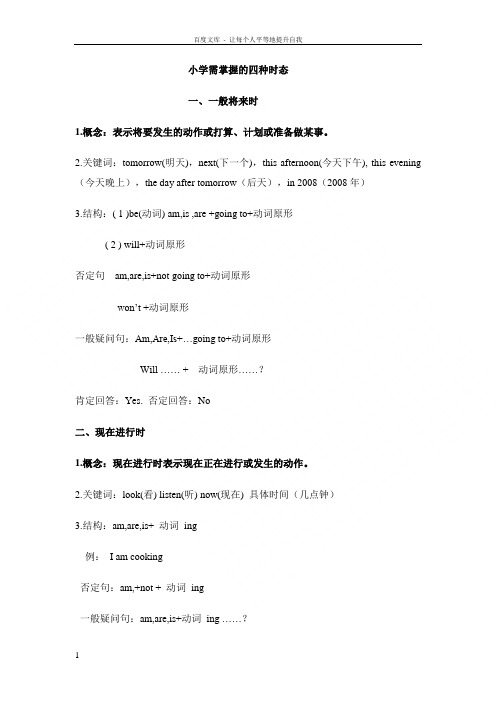
小学需掌握的四种时态一、一般将来时1.概念:表示将要发生的动作或打算、计划或准备做某事。
2.关键词:tomorrow(明天),next(下一个),this afternoon(今天下午), this evening (今天晚上),the day after tomorrow(后天),in 2008(2008年)3.结构:( 1 )be(动词) am,is ,are +going to+动词原形( 2 ) will+动词原形否定句am,are,is+not going to+动词原形won’t +动词原形一般疑问句:Am,Are,Is+…going to+动词原形Will …… +动词原形……?肯定回答:Yes. 否定回答:No二、现在进行时1.概念:现在进行时表示现在正在进行或发生的动作。
2.关键词:look(看) listen(听) now(现在) 具体时间(几点钟)3.结构:am,are,is+ 动词ing例:I am cooking否定句:am,+not + 动词ing一般疑问句:am,are,is+动词ing ……?肯定回答:yes. 否定回答:No4.动词加ing 的规律:1、直接加ing: go – going; do – doing2、以不发音的e结尾,把e去掉加ing : write – writing; have – having3、双写末尾字母加ing : run – running; swim – swimming skip—skipping sit – sitting begin – beginning get – getting put – putting shop –shopping三、一般现在时1.概念:表示经常性、习惯性的动作或行为。
2.关键词:always(总是) usually(通常) often(经常) sometimes(有时) never(从不) every(每一)3.结构:第一人称:I, we;第二人称:you;第三人称复数:they+动词原形(复数)Ben and Sally,my friends2 第三人称单数He,She,It,Janet(一个)+动词+ s ( es )例:He often goes to school at 7:0否定句I,we,you,They,Ben and Sally+don’t(不)+动词原形He,She,It,+doesn’t + 动词原形一般疑问句Do+I,we,you,they,Ben and Sally+动词原形。
小学英语语法-四大时态说课讲解

小学英语语法-四大时态四大时态复习1. 一般现在时(1)一般现在时的构成(肯定句)☆ be动词:主语+be(am,is,are)+其它。
如:I am a boy.我是一个男孩。
☆行为动词:主语+行为动词(+其它)。
如:We study English.我们学习英语。
☆当主语为第三人称单数(he, she,it)时,要在动词后加"-s"或"-es"。
如:Mary likes Chinese. 玛丽喜欢汉语。
(2)一般现在时的变化☆ . be动词的变化。
[否定句]:主语+ be + not +其它。
如:He is not a worker.他不是工人。
[一般疑问句]:Be +主语+其它。
如:-Are you a student? -Yes. I am. / No, I'm not.[特殊疑问句]:疑问词+一般疑问句。
如:Where is my bike?☆ .行为动词的变化。
[否定句]:主语+ don't( doesn't ) +动词原形(+其它)。
如:I don't like bread.当主语为第三人称单数时,要用doesn't构成否定句。
如:He doesn't often play.[一般疑问句]:Do( Does ) +主语+动词原形+其它。
如:- Do you often play football?- Yes, I do. / No, I don't.当主语为第三人称单数时,要用does构成一般疑问句。
如:- Does she go to work by bike? - Yes, she does. / No, she doesn't.[特殊疑问句]:疑问词+一般疑问句。
如:How does your father go to work?*动词+s的变化规则1.一般情况下,直接加-s,如:cook-cooks, milk-milks2.以s. x. sh. ch. o结尾,加-es,如:guess-guesses, wash-washes, watch-watches, go-goes 3.以“辅音字母+y”结尾,变y为i, 再加-es,如:study-studies2.现在进行时(1)一般现在时的构成: be(am,is, are)+ 动词的ing形式。
小学四年级重要时态总结与用法归纳

小学四年级重要时态总结与用法归纳一、过去时态(Past Tense)过去时态用于表示过去发生、已经结束的动作或状态。
1. 一般过去时(Simple Past Tense)一般过去时用于描述过去的事实或经历,常与表示过去的时间状语连用,动词一般要过去式。
例句:- 我昨天去书店买了一本故事书。
- 他昨晚没有完成作业。
2. 过去进行时(Past Continuous Tense)过去进行时表示过去某个时间正在进行的动作。
由助动词“was/were”和动词的现在分词形式构成。
例句:- 我昨晚七点正在做作业。
- 我们昨天这个时候正在打篮球。
3. 过去完成时(Past Perfect Tense)过去完成时用于强调过去某个时间或动作之前已经发生的动作或状态。
由助动词“had”和动词的过去分词形式构成。
例句:- 我们去看电影之前,已经吃过晚饭了。
- 她回家后,发现她的电话已经被偷走了。
二、现在时态(Present Tense)现在时态用于表示现在正在进行或经常进行的动作,也可以表示客观真理、日程安排等。
1. 一般现在时(Simple Present Tense)一般现在时用于表示经常性的动作或行为,也可用于描述客观真理、日程安排等。
例句:- 我每天早上七点起床。
- 地球是圆的。
2. 现在进行时(Present Continuous Tense)现在进行时用于表示现在正在进行的动作,由助动词“am/is/are”和动词的现在分词形式构成。
例句:- 我正在听音乐。
- 他们正在打扫教室。
3. 现在完成时(Present Perfect Tense)现在完成时表示过去发生的某个动作对现在产生的影响或结果。
由助动词“have/has”和动词的过去分词形式构成。
例句:- 我已经完成了作业。
- 她还没有去过海边。
三、将来时态(Future Tense)将来时态用于表示将来要发生的动作或状态。
1. 一般将来时(Simple Future Tense)一般将来时用于表示将来的某个时间会发生的动作或状态。
小学4种时态知识点总结

小学4种时态知识点总结一、什么是时态?在语法中,时态是指动词的形式和使用方式,用来表示动作或状态发生的时间。
时态可以分为过去、现在和将来三个主要时态。
二、过去时态过去时态表示动作或状态发生在过去的时间。
常见的过去时态有以下几种:1.一般过去时一般过去时用于表示过去某个时间发生的动作或状态,通常与时间状语词(如yesterday,last week等)一起使用。
例如:•I played basketball yesterday.(我昨天打篮球。
)•She visited her grandparents last week.(她上周去拜访了她的祖父母。
)2.过去进行时过去进行时表示过去某个时间正在进行的动作。
它由“was/were + 动词的ing形式”构成。
例如:•He was studying when I called him.(我给他打电话时,他正在学习。
)•They were playing in the park yesterday afternoon.(他们昨天下午在公园里玩。
)3.过去完成时过去完成时表示在过去某个时间之前已经完成的动作。
它由“had + 过去分词”构成。
例如:•She had already finished her homework when her friend came.(她朋友来的时候,她已经完成了作业。
)•They had gone home before it started raining.(下雨之前,他们已经回家了。
)4.过去完成进行时过去完成进行时表示过去某个时间开始并持续到另一个过去时间的动作。
它由“had been + 动词的ing形式”构成。
例如:•He had been studying English for two hours when his friend called him.(他朋友给他打电话时,他已经学习了两个小时的英语了。
)•They had been waiting for the bus for half an hour before it finally arrived.(公共汽车终于来了之前,他们已经等了半个小时了。
小学的四大时态知识点总结
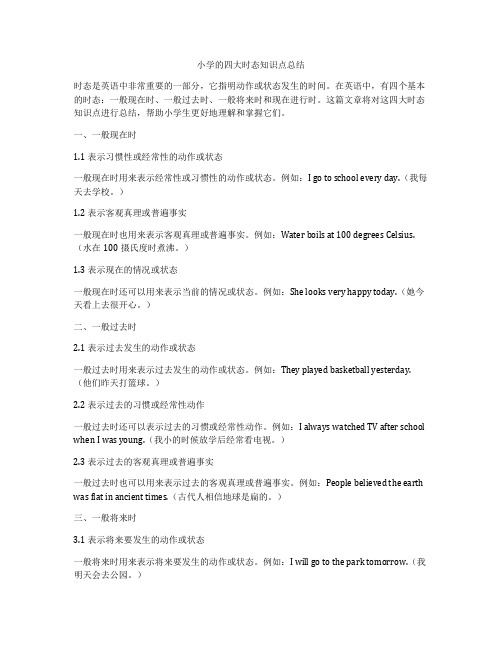
小学的四大时态知识点总结时态是英语中非常重要的一部分,它指明动作或状态发生的时间。
在英语中,有四个基本的时态:一般现在时、一般过去时、一般将来时和现在进行时。
这篇文章将对这四大时态知识点进行总结,帮助小学生更好地理解和掌握它们。
一、一般现在时1.1 表示习惯性或经常性的动作或状态一般现在时用来表示经常性或习惯性的动作或状态。
例如:I go to school every day.(我每天去学校。
)1.2 表示客观真理或普遍事实一般现在时也用来表示客观真理或普遍事实。
例如:Water boils at 100 degrees Celsius.(水在100摄氏度时煮沸。
)1.3 表示现在的情况或状态一般现在时还可以用来表示当前的情况或状态。
例如:She looks very happy today.(她今天看上去很开心。
)二、一般过去时2.1 表示过去发生的动作或状态一般过去时用来表示过去发生的动作或状态。
例如:They played basketball yesterday.(他们昨天打篮球。
)2.2 表示过去的习惯或经常性动作一般过去时还可以表示过去的习惯或经常性动作。
例如:I always watched TV after school when I was young.(我小的时候放学后经常看电视。
)2.3 表示过去的客观真理或普遍事实一般过去时也可以用来表示过去的客观真理或普遍事实。
例如:People believed the earth was flat in ancient times.(古代人相信地球是扁的。
)三、一般将来时3.1 表示将来要发生的动作或状态一般将来时用来表示将来要发生的动作或状态。
例如:I will go to the park tomorrow.(我明天会去公园。
)3.2 表示对将来的预测或打算一般将来时还可以表示对将来的预测或打算。
例如:I think it will rain this afternoon.(我觉得今天下午会下雨。
小学的四大时态知识点总结
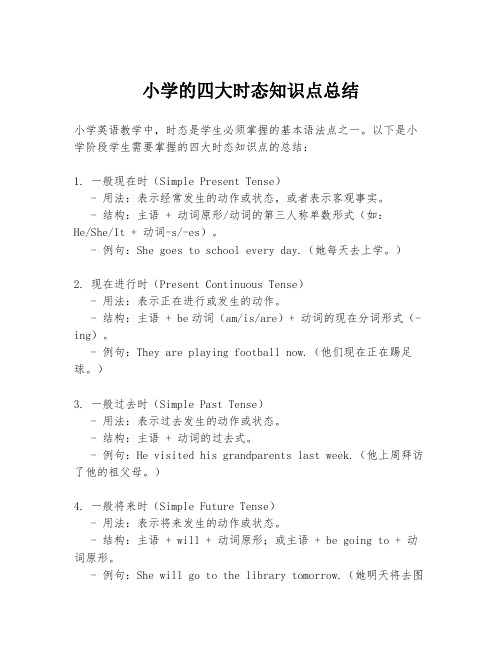
小学的四大时态知识点总结小学英语教学中,时态是学生必须掌握的基本语法点之一。
以下是小学阶段学生需要掌握的四大时态知识点的总结:1. 一般现在时(Simple Present Tense)- 用法:表示经常发生的动作或状态,或者表示客观事实。
- 结构:主语 + 动词原形/动词的第三人称单数形式(如:He/She/It + 动词-s/-es)。
- 例句:She goes to school every day.(她每天去上学。
)2. 现在进行时(Present Continuous Tense)- 用法:表示正在进行或发生的动作。
- 结构:主语 + be动词(am/is/are)+ 动词的现在分词形式(-ing)。
- 例句:They are playing football now.(他们现在正在踢足球。
)3. 一般过去时(Simple Past Tense)- 用法:表示过去发生的动作或状态。
- 结构:主语 + 动词的过去式。
- 例句:He visited his grandparents last week.(他上周拜访了他的祖父母。
)4. 一般将来时(Simple Future Tense)- 用法:表示将来发生的动作或状态。
- 结构:主语 + will + 动词原形;或主语 + be going to + 动词原形。
- 例句:She will go to the library tomorrow.(她明天将去图书馆。
)掌握这些基本时态对于小学生来说至关重要,它们是构建句子和表达思想的基础。
在学习过程中,学生应该通过大量的练习和实际应用来加深对这些时态的理解和运用。
同时,老师和家长也应该鼓励学生在日常生活中使用英语,以提高他们的语言能力。
通过不断的练习和应用,学生将能够更加熟练地掌握这些时态,并在英语交流中更加自信。
小学四种时态精讲

小学英语四种时态精讲一般现在时1.概念:一般现在时表示经常的、习惯性的动作或存在的状态,表示客观存在的事件2.构成:一般现在时的构成主要有两种形式,一般现在时用行为动词的原形,但第三人称单数作主语时,动词的词尾要加-S。
:(1)be型:句子的谓语动词是(am,is或are):a.肯定句中,只出现be,如:I am a student.我是一名学生。
b.否定句中,要在be后面加not,如:She isn't a teacher.她不是教师。
c.一般疑问句,要将be放在句子开头(注意句首字母大写),句尾用问号,答语用Yes,主语+be.或No,主语+be+not.如:—Are you ready?—你准备好了吗?—Yes,I am.—是的,我准备好了。
(—No,I'm not.—不,我没准备好。
)(2)DO型:句中的谓语动词为实义动词(也叫行为动词):a.肯定句中,只出现实义动词,如:I get up in the morning.我早晨起床。
b.否定句中,要在实义动词前面加do(does)+not,do(does)作助动词,本身无意义,常与not缩写成don't(doesn't),如:I don't like vegetables.我不喜欢蔬菜。
c.一般疑问句,要在句子开头加助动词Do(does),句尾用问号,简略答语用Yes,主语+do(does).或No,主语+do(does)+not.如:—Do you like oranges?—你喜欢桔子吗?—Yes,I do.—是的,我喜欢。
(—No,I don't.—不,我不喜欢。
)3.标志词:every…, sometimes, on Sunday,usually,often,always 现在一般时动词变化的规则是:1.如果主语是名词复数和第一人称I、 we ,谓语动词不用做任何变化,即仍然用动词原型表示:We usually go to school at 7:30. 我们通常7:30上学去。
小学英语四大时态语法知识点

小学英语四大时态语法知识点小学英语主要是如下的四大时态:一般现在时、现在进行时、一般过去时、一般将来时。
01一般现在时一、标志词always(总是)usually(通常)often(经常)sometimes(有时)never(从不)every(每一)二、基本用法1.表示事物或人物的特征、状态。
2.表示经常性、习惯性的动作。
3.表示客观现实。
三、构成1.be动词:主语+be动词(am isare)+其它.2.行为动词:主语+行为动词+其它。
四、句型肯定句:A. be 动词:be+主语+其它。
B. 行为动词:主语+动词(注意人称变化)+其它。
否定句:A.be动词:主语+be+not+其它。
B.行为动词:主语+助动词(do/does)+not+d动词原形+其它一般疑问句:A.be动词:be+主语+其它。
B.行为动词:助动词(Do/Does)+主语+动词原形+其他.特殊疑问词:疑问词+一般疑问句02现在进行时一、标志词now(现在), look(看),listen(听)二、基本用法表示现阶段正在进行的动作三、基本结构1.肯定句:主语+be动词+动词现在分词(ing)+其它。
2.否定句:主语+be动词+not+动词现在分词(ing)+其它。
3.一般疑问句:be动词+主语+现在分词(ing)+其它。
4.特殊疑问句:疑问词+一般疑问句。
03一般将来时一、标志词tomorrow(明天),soon(不久),will(将要=be going to)二、基本用法表示在在将来某个时间要发生的动作或存在的状态。
三、基本结构1.肯定句:主语+ be going to + 动词原形。
主语+will+动词原形。
2.否定句:主语+ be going to +动词原形。
主语+won’t + 动词原形3.一般疑问句:Be + 主语+ going to+动词原形Will + 主语+ 动词原形4.特殊疑问句:疑问词+一般疑问句04一般过去时一、标志词yesterday(昨天),ago(以前),before(在...之前)二、用法1.表示过去某个时间发生的动作或存在的状态,常和表示过去的时间状语连用。
完整版小学英语四大时态总结

小学英语四大时态总结小学英语四大时态总结一.一般现在时:1. 一般现在时的简单用法:表示经常的,习惯性的动作或存在的状态。
一般现在时经常与often,always,usually,sometimes,every day等时间状语连用。
否定句:主语+ be + not +其它。
如:He is not a worker.他不是工人。
一般疑问句:Be +主语+其它。
如:-Are you a student? -Yes. I am. / No, I'm not. 特殊疑问句:疑问词+一般疑问句。
如:Where is my bike? 5. 行为动词的变化。
否定句:主语+ don't( doesn't ) +动词原形(+其它)。
如:I don't like bread. 当主语为第三人称单数时,要用doesn't构成否定句。
如:He doesn't often play. 一般疑问句:Do( Does ) +主语+动词原形+其它。
如:- Do you often play football? - Yes, I do. / No, I don't. 当主语为第三人称单数时,要用does 构成一般疑问句。
如:- Does she go to work by bike? - Yes, she does. / No, shedoesn't. 特殊疑问句:疑问词+一般疑问句。
如:How does your father go to work? 二.现在进行时:1.现在进行时:表示现在正在进行或发生的动作,也表示当前一段时间内的活动或现阶段正在进行的动作。
2.结构:be ( am, is, are )+doing (所有的动词+ing)3.ing 的变化规则:2).现在进行时的一般疑问句把be动词调到句首。
Is he working at home? 3).现在进行时的特殊疑问的基本结构为:特殊疑问词+ be + 主语+ 动词ing? What are you doing? 三.一般过去时:Page 1 of 6.I. 一般过去时的概念:表示过去某个时间发生的动作或存在的状态。
小学英语中常见的四个时态知识点总结
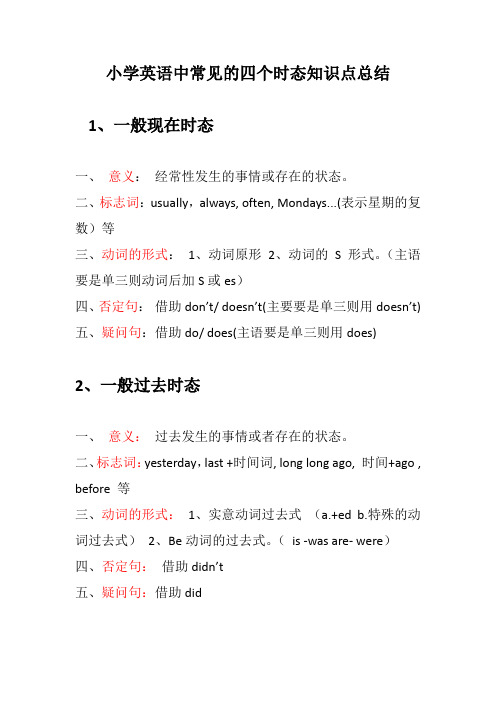
小学英语中常见的四个时态知识点总结1、一般现在时态一、意义:经常性发生的事情或存在的状态。
二、标志词:usually,always, often, Mondays...(表示星期的复数)等三、动词的形式:1、动词原形2、动词的S形式。
(主语要是单三则动词后加S或es)四、否定句:借助don’t/ doesn’t(主要要是单三则用doesn’t)五、疑问句:借助do/ does(主语要是单三则用does)2、一般过去时态一、意义:过去发生的事情或者存在的状态。
二、标志词:yesterday,last +时间词, long long ago, 时间+ago , before 等三、动词的形式:1、实意动词过去式(a.+ed b.特殊的动词过去式)2、Be动词的过去式。
(is -was are- were)四、否定句:借助didn’t五、疑问句:借助did3、一般将来时态一、意义:将来要发生的事情或存在的状态。
二、标志词:tomorrow,next +时间词等三、动词的形式:1、will +动词原型2、Be(be 包括am, is, are)going to + 动词原型四、否定句:1. 借助will not =won’t 2. be 词后面加not.( am not , is not = isn’t , are not = aren’t)五、疑问句:1. 将will 提前首字母大写;2、将be 词提前(am, is, are)但是要注意I am 或者We are 要变成Are you...?/4、现在进行时态一、意义:正在发生的事情。
二、标志词:now, look , listen 等三、动词的形式:be + doing( 动词的ing形式,特殊的要记住)四、否定句:be 词后面加not.( am not , is not = isn’t , are not = aren’t)五、疑问句:1、将be 词提前(am, is, are)但是要注意I am 或者We are 要变成Are you...?。
小学英语四大时态

小学英语-四大时态总结小学英语-四大时态总结1一般现在时一、标志词:always( 总是 ) usually( 通常 ) often( 经常 ) sometimes( 有时 ) never( 从不 ) every( 每一 )二、一般现在时动词变化规律:1、多数在动词后加 s play —plays like —likes2、以 s,x,sh,ch ,o 结尾的动词加 es wash –washes catch –catches do –does3、以辅音字母加 y 结尾,把 y 改 i 再加 es fly—flies study —studies4、以元音字母加 y 结尾,直接加 s buy – buys5、不规则变化 have —has三、一般现在时基本用法功能1.表示事物或人物的特征、状态。
如:The sky is blue. 天空是蓝色的。
2.表示经常性或习惯性的动作。
如:I get up at six every day. 我每天六点起床。
3.表示客观现实。
如:The earth goes around the sun. 地球绕着太阳转。
The earth is round.四、构成1. be 动词:主语 +be(am,is,are)+ 其它。
如:I am a boy. 我是一个男孩。
2.行为动词:主语 +行为动词 (+其它 )。
如:We study English. 我们学习英语。
五、句型肯定句:A.be 动词:主语 + be + 其它成分He is a worker.B. 行为动词:主语 +动词 (注意人称变化 ) + 其它成分We like the little cat.否定句:A.be 动词:主语 + be + not + 其它成分They are not students.B. 行为动词:主语 +助动词 (do/does) + not + 动词原形 +其它成分We don’t like the little cat.一般疑问句:A.be 动词:Am / Is /Are + 主语 + 其它成分Are you a teacher? Yes, I am. / No, I am not.Are they students of your school.Yes they are / No they aren,t.B. 行为动词:助动词 (Do/Does) +主语 +动词原形 + 其它成分Do you like it? Yes, I do. / No. I don’t .Does he(she) like it? Yes, he( she )does. / No, he( she )doesn’t.特殊疑问句:疑问词 + 一般疑问句A.be 动词:How many students are there in your school?B. 行为动词:What do you usually do on Sunday?一般现在时动词 be 和 have 的变化形式1.动词 Be 叫连系动词 , 用法:第一人称单数用 am ,第三人称单数用 is,其它人称用 are。
小学英语语法时态讲解与归纳总结
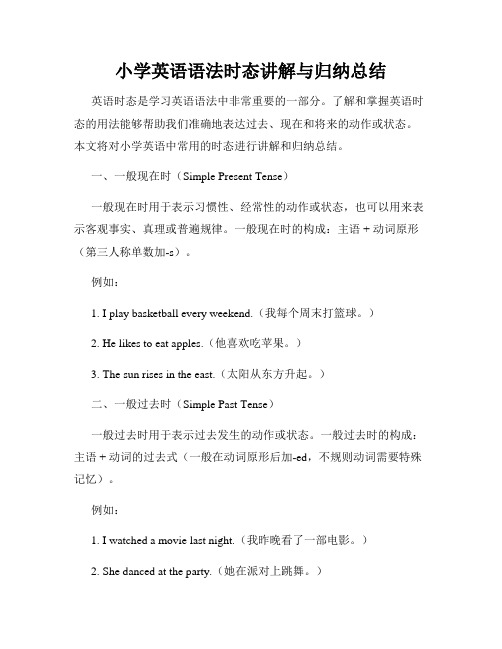
小学英语语法时态讲解与归纳总结英语时态是学习英语语法中非常重要的一部分。
了解和掌握英语时态的用法能够帮助我们准确地表达过去、现在和将来的动作或状态。
本文将对小学英语中常用的时态进行讲解和归纳总结。
一、一般现在时(Simple Present Tense)一般现在时用于表示习惯性、经常性的动作或状态,也可以用来表示客观事实、真理或普遍规律。
一般现在时的构成:主语 + 动词原形(第三人称单数加-s)。
例如:1. I play basketball every weekend.(我每个周末打篮球。
)2. He likes to eat apples.(他喜欢吃苹果。
)3. The sun rises in the east.(太阳从东方升起。
)二、一般过去时(Simple Past Tense)一般过去时用于表示过去发生的动作或状态。
一般过去时的构成:主语 + 动词的过去式(一般在动词原形后加-ed,不规则动词需要特殊记忆)。
例如:1. I watched a movie last night.(我昨晚看了一部电影。
)2. She danced at the party.(她在派对上跳舞。
)3. They visited their grandparents yesterday.(他们昨天去拜访了他们的祖父母。
)三、一般将来时(Simple Future Tense)一般将来时用于表示将来要发生的动作或状态。
一般将来时的构成:主语 + will + 动词原形。
例如:1. We will go shopping tomorrow.(我们明天要去购物。
)2. He will finish his homework later.(他一会儿会完成他的家庭作业。
)3. She will visit her friends next week.(她下周要去拜访她的朋友们。
)四、现在进行时(Present Continuous Tense)现在进行时用于表示现在正在进行的动作。
小学四种时态讲解及专项练习
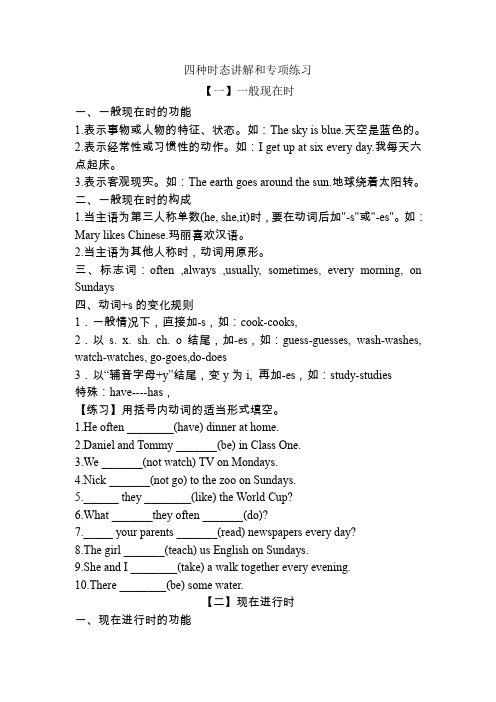
四种时态讲解和专项练习【一】一般现在时一、一般现在时的功能1.表示事物或人物的特征、状态。
如:The sky is blue.天空是蓝色的。
2.表示经常性或习惯性的动作。
如:I get up at six every day.我每天六点起床。
3.表示客观现实。
如:The earth goes around the sun.地球绕着太阳转。
二、一般现在时的构成1.当主语为第三人称单数(he, she,it)时,要在动词后加"-s"或"-es"。
如:Mary likes Chinese.玛丽喜欢汉语。
2.当主语为其他人称时,动词用原形。
三、标志词:often ,always ,usually, sometimes, every morning, on Sundays四、动词+s的变化规则1.一般情况下,直接加-s,如:cook-cooks,2.以s. x. sh. ch. o结尾,加-es,如:guess-guesses, wash-washes, watch-watches, go-goes,do-does3.以“辅音字母+y”结尾,变y为i, 再加-es,如:study-studies特殊:have----has,【练习】用括号内动词的适当形式填空。
1.He often ________(have) dinner at home.2.Daniel and Tommy _______(be) in Class One.3.We _______(not watch) TV on Mondays.4.Nick _______(not go) to the zoo on Sundays.5.______ they ________(like) the World Cup?6.What _______they often _______(do)?7._____ your parents _______(read) newspapers every day?8.The girl _______(teach) us English on Sundays.9.She and I ________(take) a walk together every evening.10.There ________(be) some water.【二】现在进行时一、现在进行时的功能现在进行时表示现在正在进行或发生的动作,也可表示当前一段时间内的活动或现阶段正在进行的动作。
- 1、下载文档前请自行甄别文档内容的完整性,平台不提供额外的编辑、内容补充、找答案等附加服务。
- 2、"仅部分预览"的文档,不可在线预览部分如存在完整性等问题,可反馈申请退款(可完整预览的文档不适用该条件!)。
- 3、如文档侵犯您的权益,请联系客服反馈,我们会尽快为您处理(人工客服工作时间:9:00-18:30)。
英语语法时态详解动词时态1. 表示经常发生的动作或存在的状态一. 一般现在时的基本用法常和always, usually, often, sometimes, every day, every week 等时间状语连用。
He is often late.He goes to work every day.Do you driveHe teaches English.2. 表示普遍真理由于是众所周知的客观事实,所以一般不用时间状语。
The earth is roun.3. 有些表示心理状态或感情的动词往往用一般现在时表示。
I want your help. I don’t think you are right. Does it (your leg) hurt 疼吗(腿疼吗)4. 在时间。
条件状语从句中表示将来要发生的动作。
If it doesn’t rain tomorrow, We’ll go to the Summer Palace.When he gets to the village, he will write to me.5. 表示已经预先计划或安排的肯定要发生的动作主要用于come, go, start, begin, leave, return, stop 等瞬间动词,句中常有表示将来时间的状语。
Next week they leave for Shanghai. Our holidays begin in a week.6. 其他Here comes Li Ming! There goes the bell. Here he comes.二. 一般过去时的基本用法1. 带有确定的过去时间状语时,要用过去时如:yesterday(昨天), two days ago……(两天前……), last year……(去年……),the other day (前几天), once upon a time(过去曾经) just now in the old days (过去的日子里), before liberation(解放前……),When I was 8 yeas old(当我八岁时……)Did you have a party the other dayLei Feng was a good soldier.注意:当谈已死去的人的情况时,多用过去时。
2. 表示过去连续发生的动作,要用过去时这种情况下,往往没有表示过去的时间状语,而通过上下文来表示。
The boy opened his eyes for a moment, looked at the captain, and then died.3. 表示过去一段时间内经常或反复的动作常与always, never 等连用。
Mrs. Peter always carried an umbrella. (只说明她过去的动作,不表明他现在是否常带伞。
)比较:Mrs. Peter always carries an umbrella. (说明这是她的习惯,表明她现在仍然还习惯总带着伞。
I never drank wine. (不涉及到现在,不说明现在是否喝酒)4. 如果强调已经中止得习惯时要用used to doHe used to drink. (意味着他现在不喝酒了,喝酒这个动作终止了。
)I used to take a walk in the morning. (意味着现在不在早晨散步了。
)5. 有些句子,虽然没有表示过去确定时间的状语,但实际上是指过去发生的动作或存在的状态的话,也要用过去时,这一点,我们中国学生往往出错,要特别注意!I didn’t know you were in Paris.(这句话指的是说话之前,所以只能用过去时表示,实际上,这句话暗指:But now I know you are here. )I thought you were ill. (在说话之前,我以为你病了。
但是现在我知道你没病)三. 现在进行时态1. 现在进行时的基本用法1. 表示说话时正在进行的动作常和now连用,有时用一个动词look(看),listen(听)来表示now(现在)这一时间概念。
Look! A train is coming.Listen! He is playing the piano.2. 表示现阶段正在进行着的动作常和at present (目前),this week(本周),these days(这几天)……等时间状语连用。
What lesson are you studying this week (说话时并不在学)注意:如果没有表示将来时间的状语,此类句子就可能指现在或现阶段的动作。
Where are you going next week (用现在进行时表示将来时,因为有next week这一时间状语)3. 现在进行时有时可用来表示一个在最近按计划或按排要进行的动作即可以用来代替将来时,此时一般要与表示将来的时间状语连用,而且仅限于少量动词。
如:go(去),come(来),leave(离开),start(开始),arrive(到达),return(返回),sleep(睡觉)……Are you going to Tianjing tomorrowHow many of you are coming to the party next week4. be going to+动词原形: 这一句型表示即将发生的事或打算(准备)做的事,我们把它归在将来时里了。
She isn’t going to speak at the meeting.5. 没有进行时的动词: 表示状态. 思想. 感情和感觉的动词不能表示正在进行的动作(1) 表示感觉的感官动词例如:see(看见). hear(听见). notice(留意)等动词。
我们不能说:(×)I’m hearing the sound. (O) I hear the sound.(×)Are you hearing the noise of a plane (O) Do you hear the noise of a plane但是,如果hear不表示“听见”的意思时,可用进行时。
They are hearing an English lecture. 他们在听一个英语讲座。
(2) 表示态度和感情. 心理状态. 继续等意思的动词如:like (喜欢). Love (爱). Know (知道). Want (需要). Hope (希望). Hate (恨). Think (认为). Agree (同意). belive (相信)等。
(×)I’m liking dogs. (O) I like dogs.(3). have (has)当“拥有”讲时(×)I’m having a lot of books. (O) I have a lot of books.但当have(has)当“吃饭. 开会……玩的愉快……”等意思时,可用进行时。
We are having a good time.6. 一般现在时和现在进行时的区别(1) 一般现在时表示经常性的动作,而现在进行时表示暂时性的动作。
He walks to work. (习惯. 经常的动作)He’s walking to work because his bike is being repaired. (只是暂时的情况)Where does he live (询问一般的情况)Where is he living (staying)(询问暂时一段时间的情况)(2) 现在进行时有时可以代替一般现在时,表达说话人的某种表情,句子有强烈的感情色彩。
常与always, forever连用。
You are always forgetting the important thing. (表达出不满的情绪)Mary is doing fine work at school. (比Mary does fine work. 更富有赞许意思)7. 过去进行时(1) 过去进行时主要表示过去某一个时刻或某一阶段正在进行的动作,常和表示过去时间的状语then, at this(that) time, yesterday, at night, last night等连用。
但在不少情况下,没有表示时间的状语,这时需要通过上下文来表示。
What were you doing at nine last nightI was visiting a friend of mine most of the afternoon.(2) 当两个一长一短的动作在过去某时间同时发生时,用过去进行时表示较长的动作,过去进行时可用于主句,也可用于从句。
注意:当两个延续动作同时并列时,二者都可用进行时表达。
It was raining hard when I left my office.When you called, I was eating.When I was cleaning the windows, my brother was sweeping the floor.Some students were playing football while others were running round the track.We were walking along the river when (suddenly) it rained.They were watching TV when the lights went out.(3) 过去进行时表示将来的动作现在进行时可以表示将来的动作,同样,过去进行时也可以表示从过去某一时间看将来发生的动作。
常用在间接引语中。
She went to see Xiao Li. He was leaving early the next morning.She asked him whether he was coming back for lunch.(4) 过去进行时和一般过去时的区别过去进行时表示过去某时正在进行的动作,而一般过去时则表示一个完整的动作,也就是说用一般过去时,只表示有过这件事,用过去进行时,则强调了动作的连续性。
Li Ming washed the dishes. 李明洗过盘子了。
Li Ming was washing the dishes. 李明在洗盘子。
The children watched TV yesterday evening. 昨天晚上孩子们看了电视。
